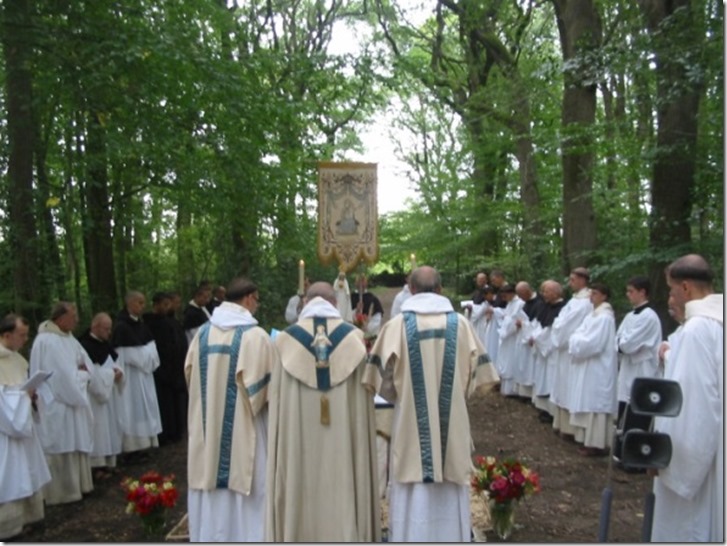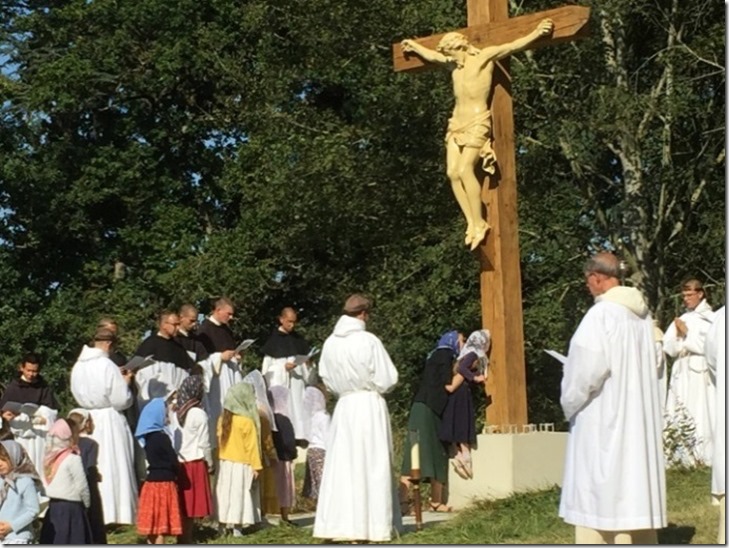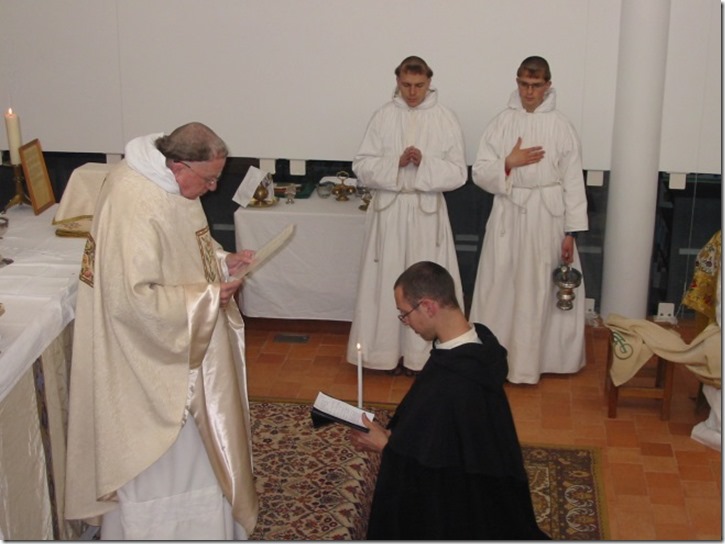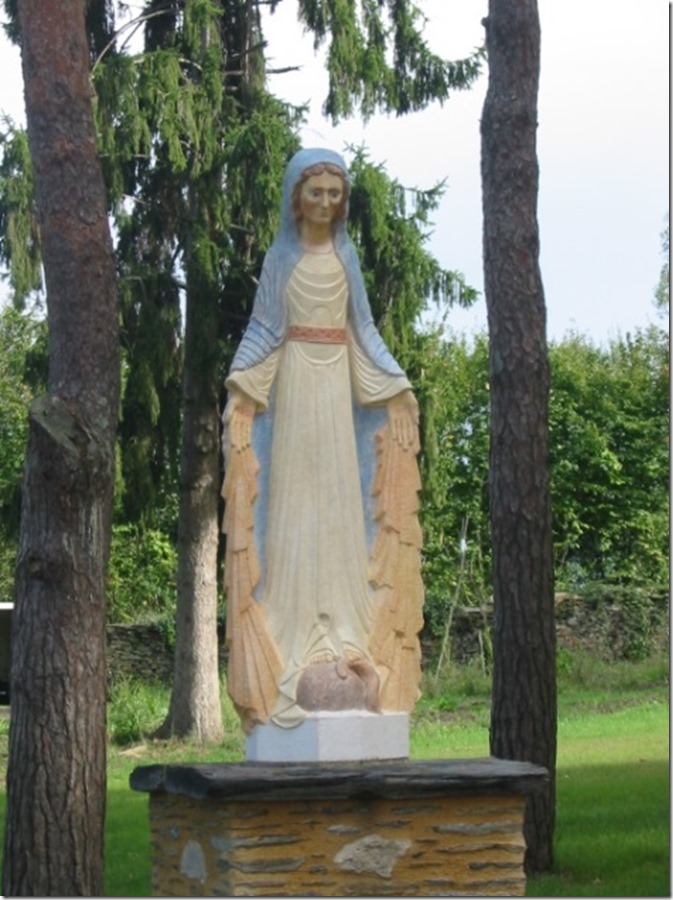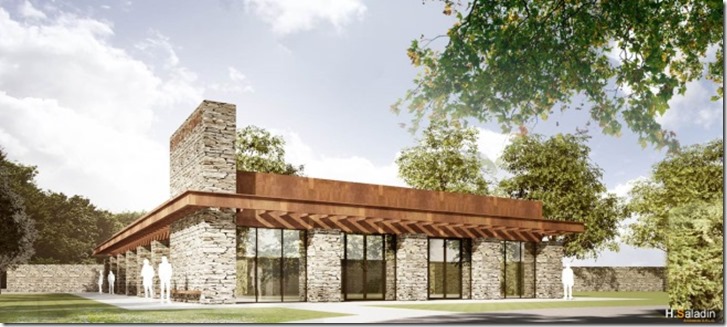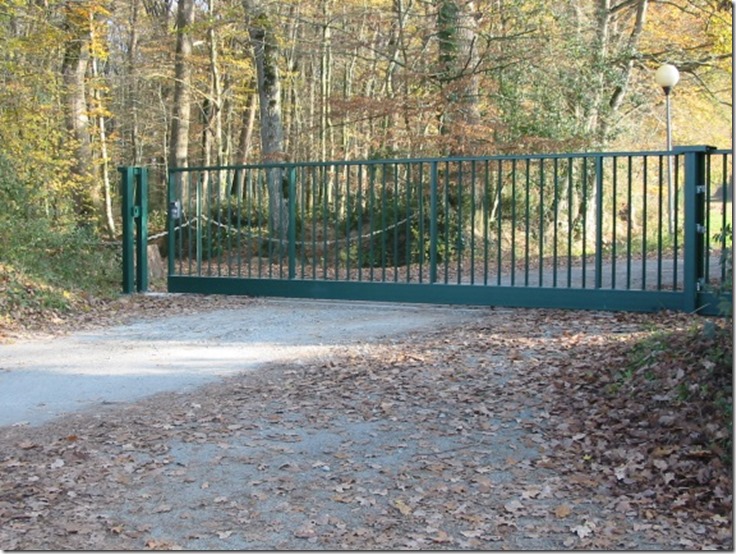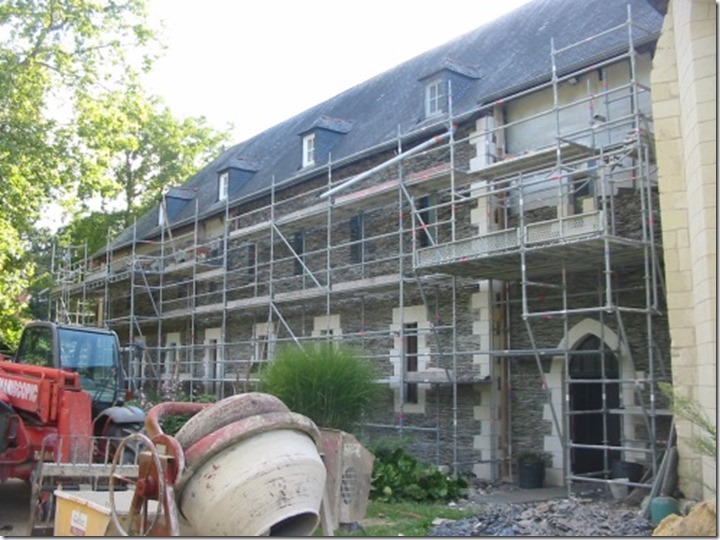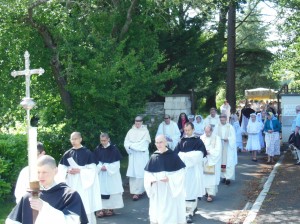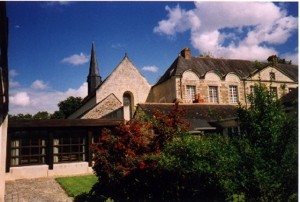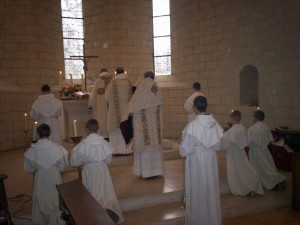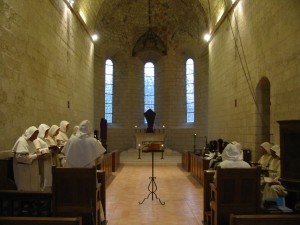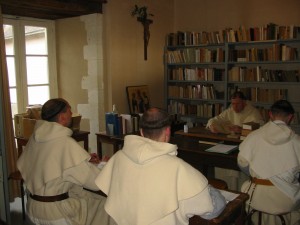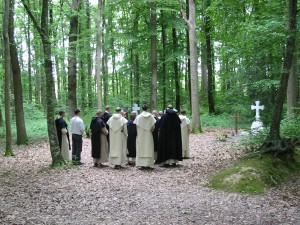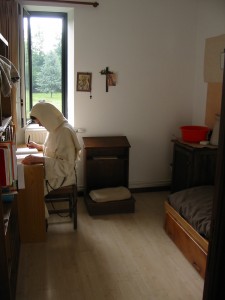Dear Superior General of the Society of the Apostles of Jesus and Mary, Your Excellency Bishop Faure,
Your Excellency Bishop Williamson,
My dear confreres in the priesthood, dear religious,
My dear friends…
All of us have come here, to Avrillé, to witness today this Catholic ceremony for the continuation of the true, royal and propitiatory priesthood that Our Lord Jesus Christ commanded His Apostles to transmit to their apostolic successors, under the Primacy of Saint Peter, Vicar of Christ, throughout the centuries until the consummation of the world. “And the eleven disciples – says Saint Matthew – went into Galilee, unto the mountain where Jesus had appointed them. And seeing him they adored: but SOME DOUBTED. And Jesus coming, spoke to them, saying: All power is given to me in heaven and on earth. Going therefore, teach ye all nations: baptizing them in the name of the Father, and of the Son, and of the Holy Ghost. Teaching them to observe all things whatsoever I have commanded you; and behold I am with you all days, even to the consummation of the world.” (St. Mathew, 28, 16- 20)
Indeed, we are here to honor Archbishop Lefebvre, our venerable Founder, for the great example he left us in preserving the Catholic priesthood expressed in the Roman Rite, in spite of the sinister darkness spread by the churchmen of the Second Vatican Council. These leaders are still waging a bitter war against Our Lord Jesus Christ, true God and true Man, and against anybody who wants to be a soldier of Christ and fight for the Kingdom of God to come on earth as it is in heaven.
In fact, Archbishop Marcel Lefebvre, as successor of the Apostles did not fail to do what he was commanded to do – Archbishop Lefebvre is, PAR EXCELLENCE, THE PRELATE who preserved the essential magnitude of the Catholic priesthood at the end of the twentieth century, not only by transmitting the authentic mark of Apostolicity in the Catholic Church by the Episcopal Consecrations of June 30th 1988, but also for keeping the complete integrity in the Deposit of the Faith, expressed in the doctrine of the Holy Sacrifice of the Mass by the propitiatory element of atonement for the remission of sins, which Our Lord Jesus Christ offered to His eternal Father by His crown of thorns from the Cross as conquering throne.
So, my simple words today mean to sound like an echo of reverberations through a valley, so that they might bring back to our mind the heroic testimony left by Archbishop Lefebvre. I would like to recall in particular the words of three of his sermons:
The first, on that occasion the 1976 Ordinations in which Archbishop Lefebvre spoke about how a priest participates in the grace of Union in Our Lord Jesus Christ and why the Holy Sacrifice of the Mass must be monarchical and not democratic.
The second, on the celebration of his golden priestly jubilee in 1979, when he launched a Crusade for clergy and laity for the purpose to continue the Holy the Mass of always.
The third, on the occasion of the Mass in Lille on August 29, 1976, when Archbishop Lefebvre declared, not only that the devil is the Father of Lies – the Father of Error – but also that Error and truth are not compatible. He also mentioned three errors of the conciliar church, namely: the fact that it engaged in a dialogue with Protestants to produce the bastard new mass and bastards sacraments; the fact that it promoted an abominable dialogue with Freemasons and Communists, to build a bastard union of confusion; the fact that it rejected the social reign of Our Lord Jesus Christ under the pretext that it is no longer possible.
In addition, we are here today to congratulate His Excellency Bishop Richard Williamson on the 35th anniversary of his episcopal consecration, and wish him more years to come – Ad Multos Annos! Thank you for sharing that marvelous gift of knowledge composed in master strokes of the pen that, when read, sound like a harmonious melody running in a natural waterfall. Thank you for transmitting your tremendous conviction in eternal Truth, for your love to the only Savior of the world – Our Lord Jesus Christ, when speaking with eloquence throughout your conferences, speeches, and sermons… Perhaps for certain people your words might sound as “a scandal,” for others they might seem “foolish”, but for many, very many others your words are a voice crying out in the wilderness of the modern ungodly world… May the Mother of God, the Madonna who watched over you from above the gate of Winchester School in England, keep you always under her maternal mantle to preserve you from any attack of evil-doers. So, we are glad to be here with Your Excellency for this celebration – Deo Gratias! As Saint Paul said: “Let a man so look upon us as the ministers of Christ, and the dispensers of the mysteries of God. Here now it is required among the dispensers that a man be found faithful.” (1Cor. 4, 1- 2)
And last but not the least, we are here – my dear abbé Blanchet, to rejoice with all your family, and to congratulate your dearly beloved Father and Mother for their perseverance in saying the evening prayers every night together at home. In truth, “a family that prays together, stays together.” Doubtless to say that the presence of many relatives and friends, who have come to attend your priestly ordination, is a demonstration of trust and a charitable support they have shown you throughout your way to the Catholic priesthood: all those teachers that Divine Providence has placed on your life, like your music teacher who will enhance this ceremony, and all the members of the Dominican Community here… all want to thank God for the merciful gift of your priestly vocation. May you be found faithful to it until the last breath of your life…
*
So, my dear friends, just as before the Ascension of Our Lord into heaven “some [bishops] doubted,” and since then, many other bishops have also doubted in their duties throughout the centuries. Even more, today’s bishops have lost their grip on reality and objective Faith, so that they live an electronic-subjective way of life in the atheist modern world, with all materialistic comforts and with a gnostic understanding of life and death.
That’s why there are many Christians torn apart in their families, in their homes, among their children. Many of us are torn in our heart by the divisions in the Church, provoked by this new religion being taught and practiced since Vatican II… Indeed, charity has grown cold, and people have lost the love of Truth. The whole world believes more in the Internet than in the Bible, which is why Saint Paul said: “…and in all seduction of iniquity to them that perish: because they receive not the love of the truth, that they might be saved. Therefore God shall send them the operation of error, to believe lying.” (2 Thessal, 2, 10)
Living in a convulsive world of war, famine and pests, it is unbelievable to hear that the Synodal Church is preaching a “new evangelization” about everything, but not about the Holocaust of Christ on Calvary. One might ask to oneself, when will the day that the Vicar of Christ will turn back to lead all nations to Tradition as it has always been believed everywhere, and by all?
When Archbishop Lefebvre was asked this question, he responded: “[…] when Rome crowns Our Lord Jesus Christ as King, once again. We cannot have an agreement with those who have uncrowned Our Lord. The day when they will once again recognize and acknowledge Our Lord to be King of all peoples and nations, then it will not be we whom they have joined, but rather the Catholic Church, in which we have been dwelling and remaining.” (AL, Flavigny, December 1988, Fideliter #68, p 16)
While waiting for the conversion of the modern pagan Rome and the abolition of human slavery which is the fruit of the Globalist Agenda, in today’s world, what can a Catholic priest do?
In this perspective, let us listen to the preaching of the Eminence of Poitiers, the venerable Cardinal Pie, who is well-known for having taught the perennial doctrine of Jesus Christ’s rights to govern individuals, families and nations, and for having proclaimed His royal rights over the international laws of nations. We should read and re-read the abundant wisdom contained in the writings of Cardinal Pie, who is the Master and Doctor in the doctrine of the Kingship of Christ:
“The main benefit to draw from error, heresy and from all oppositions which Truth will meet among men, is that the very same point that is particularly being denied and fought against, soon after there will be a light shed upon it and then it will be glorified.[…] Upon which topics religious writers – and most especially spiritual counselors and spiritual doctors of the nations – must concentrate their discussions, demonstrations and teachings? […] Well, observe from which side error is directing their attacks, its negations, its blasphemies. So, whatever is being attacked, denied, and blasphemed in each century or age, it is precisely in which it must be defended, affirmed, and repaired. Where sin abounds, grace most necessarily super-abound. So, against the darkening of spirits, against the increase of coldness in hearts, we must oppose an overflow of light, a fresh outbreak of love.” (Cardinal Pie, Third synodal instruction on the principal errors of the present age, July 1862 – August 1863, Complete Works, V, pages 36-37)
It is evident that, in attacking Our Lord Jesus Christ and Christendom, the enemies of God have concentrated their strategies to fight against Truth, against Authority, and against the Priesthood. Hence, let us summarize what a priest can do to defend Truth against Error, to uphold Authority in the face of anarchy and chaos, and to preserve the sacred priesthood against the profane ministry promoted by the Second Vatican Council.
Needless to say that a Catholic Priest is a principle of Order. A good Priest recapitulates everything in Christ the King. In so doing, he fosters the spiritual and temporal common good of families and of countries, because he is the salt of the earth, and the light of the world. But when a Priest fails in his duties, then he compromises with the three enemies of the soul: the world, the lust and the devil. As a matter of fact, Corruptio optimi, pessima! (The corruption of the best, is the worst!) That’s why Don Bosco used to say that when a priest dies, he never goes alone, but with many people, either to heaven or to hell.
Therefore, on the day of his Ordination the Catholic Priest receives the power to become a principle of order in Spiritus Veritatis (in the Spirit of Truth), as Our Lord Jesus Christ commanded the Apostles to do. So, here are some words concerning this triple power.
The first is the power of teaching – potestas docendi. This power commands an unity in doctrine to learn and to practice the same Catholic religion among the clergy and laity. It is an unity in that Faith which has been believed everywhere, always, and by all: “quod ubique, semper, et ab omnibus” (Communitorium, St. Vincent Lerin).
The second is the power of governing – potestas regendi. This power requires unity in hierarchy: Jesus Christ is Head of the Church, the Pope is the Vicar of Christ, Bishops are the apostolic successors, Priests are other Christs, and faithfuls are the witnesses of eternal salvation. In this hierarchy, all power comes from God, as Saint Paul says, “Omnis potestas a Deo.” (Rom. 13, 1)
The third is the power of sanctifying – potestas sanctificandi. This power is linked to an unity in Liturgy as the official way of Church worship by clergy and faithful. The law of prayer is indeed the law of Faith: lex credendi, lex orandi.
*
1. The Power of Teaching: the Faith that has always been believed everywhere and by all
“The lips of the priest – says the prophet Malachias – shall keep knowledge, and they shall seek the law at his mouth, because he is the messenger of the Lord.” (Malach. 2, 7)
“Because thou hast rejected knowledge, I will reject thee that thou shalt not do the office of priesthood to Me,” said the prophet Osee. ( 4, 6)
Almighty God wants men to help Him save souls. He could have done this by other means. However Jesus Christ became man Himself , and He willed that some men become priests through the grace of the Sacrament of Holy Orders, like His Apostles who were ready to convert the whole world, or like anyone of the priests here present, who are willing to convert the modern world for the greater glory of God and the eternal salvation of souls.
The Sacrament of Holy Orders constitutes the imposition of the bishop’s hands upon the head of the deacon as the Matter of the sacrament. For the sacramental Form are required the words of the Preface in the Rite of Ordination, which clearly express the bishop’s intention to do what has always been done in the Catholic Church, to believe everywhere and by all.
Among his functions, a priest must faithfully teach the very Word of God to those who wish to be the children of God, instructing them through the Church Magisterium. Hence, he must believe in the two sources of divine Revelation, namely, the Holy Scripture and the Oral Tradition transmitted by the Apostles to their apostolic successors.
As the meaning of the word “apostle” requires, the priest must be sent to preach under the authority of a bishop. Archbishop Lefebvre said that “In consecrating his life to the apostolic ministry and since he continues the mission which Our Lord Jesus Christ fulfilled on earth, he is essentially sent as missionary.” (AL, June 29 1978). So, the priest is sent by God, under the authority of the Catholic Church in order to preach the Apostles’ Creed, the Ten Commandments, the Seven Sacraments, the Our Father and other prayers, in order to lead his flock for their eternal salvation.
During this ceremony, the Catholic Church says through the mouth of the bishop: “Agnosce quod agis, imita quod tractas,” that is, “Realize what you are doing. Imitate what you operate”. The priest must therefore believe that he dispenses God’s graces through the Sacraments which are the ordinary channels, instituted for that purpose by Our Lord Jesus Christ Himself. It is the priest’s duty to provide the proper MATTER, the correct FORM, and the right INTENTION of the sacraments, in order to validly administer them to his flock, and when needed to receive them himself alike. It would be a serious negligence, if a priest would not provide all that is needed for such a purpose, as it would be a negligence for a bishop who would not provide to his priests all what is needed for them to properly administer the sacraments to the faithful.
The most important duty is to re-actualize by his priestly ministry the same Sacrifice that Our Lord Jesus Christ made on the Cross at Calvary, in an un-bloody manner, under the species of bread and wine, so that he is bringing God from heaven down onto the altar for the eternal salvation of souls.
It is imperative to meditate on the grace in which this young priest is going to participate in the Catholic priesthood. It is not by the sanctifying grace which Our Lord Jesus Christ gives us through Baptism. It is by the grace of union – that grace of union unique to Our Lord Jesus Christ. For it is by His grace of union with the divinity of God, with the divinity of the Word, that Our Lord Jesus Christ became Priest, that Our Lord Jesus Christ is King, and by that Our Lord Jesus Christ is Judge. Truly, Our Lord Jesus Christ ought to be adored by all men because of this grace of union, which is a sublime grace! This grace from the divinity Itself, in a unique manner descended into His humanity in the fullness of time, anointing Our Lord Jesus Christ in a special manner, as the holy Oil descending on the head of the recipient, anoints the one who receives its unction. Our Lord Jesus Christ’s humanity was penetrated by the divinity of the Word of God, and thus He was made Priest and became Mediator between God and men.
Participating in that grace, the priest is a real mediator between God and men. In receiving the priestly ordination, a priest is not any longer like any other man; he is consecrated for God and separated from men. At Mass, for example, before turning to say “Dominus vobiscum”, the priest must kiss the altar in order to express his function of mediator between God and men, as a bridge between heaven and earth, uniting the prayers of the faithful to the sacrifice of the altar.
Also, it is important to note some of the accessory ceremonies of the priestly ordination in the Roman Rite:
Firstly, the bishop clothes the priest with a stole, crossing it over his chest to remind him of the Cross of Our Lord, and with a chasuble which symbolizes the submission a priest must have to the binding yoke of God’s Law through a life of sanctity and purity.
Secondly, the bishop anoints the priest’s hands with the holy Oil of catechumens, binds them together, and in presenting him the chalice and paten, he says these words: “receive the power to offer to God the Sacrifice, and to celebrate Mass for both the living and the dead.”
Thirdly, at the end of the ceremony, the bishop confers on the new priest the divine power to forgive sins when saying: “Receive the Holy Ghost, the sins you forgive they will be forgiven, and the sins you retain, they will be retained.”
The above said priestly ceremonies are not contained in the new Rite of Ordination implemented after the Second Vatican Council. Perhaps these blessings are not by themselves necessary for the validity of the new Rite of Ordination, but their omission and the absence of any other liturgical expression do not clearly manifest the intention by which the bishop is ordaining the priest. Otherwise, the functions assigned to the priest in the new Rite could signify the bishop’s intentions, namely, to preside at the assembly of the people of God; to face the people when saying the New Mass; to remove the tabernacle from the center of the altar; to give Communion on the hand… These expressions are absolutely consistent with the fundamental mentality of modern man. The New Mass is not a hierarchical Mass instituted from above; on the contrary, it is a democratic Mass instituted from below, by the people, for the people and with the people. It is the expression of a man-centered cult, created by man who wants to make himself god.
Archbishop Lefebvre said concerning the New Mass: “The ideology of modern man has been brought into our most sacred Rites. This is why we think that we cannot accept the new Rite, which is the work of another ideology, or a new ideology.” (AL, June 29, 1976).
And again: “May seminarians, priests and bishops find the understanding of their priesthood in these few fundamental truths about the grace of union in Our Lord, and appreciate the sublimity of the heritage bequeathed to them, which must be the source of their sanctification and the source of their apostolate: the act of sacrifice.
Our Lord’s act of Sacrifice being the act which constitutes the Sacrament of the Eucharist – the life of Christ, Priest and Victim – must be the foundation of our interior life as well as of our ministry in giving Jesus to souls. This indissoluble union of the Sacrifice and the Sacrament which the Word Incarnate in His wisdom willed, is precisely what the Protestants reject and the innovators of Vatican II have in practice made it disappear by Ecumenism!” (AL, Spiritual Journey, p. 35)
“It must be understood immediately that we do not hold to the absurd idea that if the New Mass is valid, we are then free to assist at it. The Church has always forbidden the faithful to assist at the Masses of heretics and schismatics, even when they are valid. It is clear that no one can assist at sacrilegious Masses or at Masses which endanger our faith.” (AL, November 8, 1979)
God never abandons His Church; and so the number of priests will be always sufficient for the needs of the faithful, provided that the worthy priests remain faithful to the deposit of the Faith, and that those who profess heresy and who un-repentantly transgress the moral laws are removed from the ministry. As the fourth Ecumenical Lateran Council said, should it ever become impossible to maintain the present number of priests “it is better to have a few good priests than a multitude of bad ones.” (decree 27, De instructione ordinarum).
Therefore, dear abbé Blanchet:
Always, celebrate the Holy Sacrifice of the Mass, knowing what Mass is and how to say it, following Archbishop Lefebvre’s example.
Never say Mass in a hurry, in less than 20 minutes, because it would scandalize the faithful, as Father Prümer says, then it would be a matter to go to confession.
Never say the New Mass.
Be faithful to the recitation of the Breviary everyday.
Preach the evangelical counsels of chastity, obedience, and poverty.
Be faithful to your total consecration to the Blessed Virgin Mary, pray your daily rosary and beware of private revelations.
Because the priest is a principle of order, when preaching the Truth always, he should be supported by his Bishop and he will be faithful to his priesthood. Saint John says, “And this is eternal life that they might know Thee the only true God, and Jesus Christ that Thou has sent.” (St John 17, 3)
*
2. The power of governing: all power comes from God.
There cannot be priests without bishops, and no bishops without apostolic succession, and no Vicar of Christ without a successor of Saint Peter, and no Catholic Church without Jesus Christ, true God and true Man. “Let every soul be subject to higher powers: for there is no power but from God: and those that are, are ordained of God.” (Rom. 13,1) The superiors must provide for the doctrinal formation of their subjects, and not otherwise. How can priest pretend to hold authority in himself, if he would break the chain of command? At his ordination, the priest becomes “the lieutenant of Christ the King” for the purpose to establish the Kingdom of God on earth as it is in heaven.
Is the traditional movement a rebellion to Authority? Was Archbishop Lefebvre against Church Authority?
Resisting in the spirit of Truth, Archbishop Lefebvre preserved the Deposit of the Faith including the Papacy itself from the destructive danger formulated by the innovations of the Second Vatican Council. Archbishop Lefebvre himself explained the reasons for which one should resist a higher authority. “ […] What is the first principle to know what we must do in this circumstance, in this crisis in the Church? What is the principle?
This doctrine is expounded by Saint Thomas Aquinas. So what does Saint Thomas Aquinas say about the authority in the Church? When can we refuse something from the authority of the Church? PRINCIPLE: ‘Only when the Faith is in question.’ Only in this case. Not in other cases… Only when the Faith is in question… and that is found in the Summa Theologica (II II Q.33, a.4, ad 2m) […].” (AL, St. Them Aquinas Seminary, Ridgefield, 1983)
“We resist and shall continue to resist, not in a spirit of contradiction or rebellion, but in a spirit of fidelity to the Church, of fidelity to God, to our Lord Jesus Christ, to all those who taught us our holy religion; by a spirit of fidelity to all the Popes who maintained Tradition. That is why we are determined quite simply to continue, to persevere in the Tradition which sanctified the saints who are rendering an immense service to all the faithful who wish to keep the faith and truly to receive the grace of our Lord Jesus Christ.” (AL, Écône November 1, 1980)
Certainly, most traditional Priests and Bishops might agree on many doctrinal points. Perhaps we might have the same doctrine about the Catholic Church, about moral theology; and we might be ready to follow Saint Thomas Aquinas in his objective philosophy and in dogmatic theology… But when it comes to interpreting the present crisis in the Church today, and the future collapsing of the world… we might not have the same interpretation, the same thinking and understanding… Indeed, it is a big problem in which Divine Providence wants us to survive, as it was in that time when three Popes at the same time claimed to be THE REGNANT POPE, and whom Kings, Bishops, Priests and Faithful did defended and believed… and Christendom was divided. The history of Tradition today is a history of divisions! And today we Catholics are in the risk to fall into error, either by heresy or by schism. But as Archbishop Lefebvre said, we do not want to be heretic nor schismatic!
On the other hand, the Father of Lies is at work, coming again and again to divide in order to conquer. That’s why Pope Pius IX, wanting to warn us, allowed the publication of a book entitled The Roman Church and the Revolution, written by Crétineau-Joly (on February 25, 1861). Here is an interesting excerpt recording a conversation between two Freemason leaders: “…You want to establish the kingdom of the elects on the throne of the prostitute Babylon, in which the clergy follows under your standards, believing always that they walk under the standard of the apostolic keys… If you do not precipitate, we promise a catch more miraculous than his.’ The fisher man who catches fish becomes a fisher man to catch men. You will be surrounded by friends of the Apostolic Chair. You will preach a revolution by [Papal] Tiara and Cope walking under the banner and the standard of the cross, a revolution that needs nothing else but a spark to kindle a fire throughout the four corners of the world.”
Under the same circumstances, let us remember the words of Our Lord to Saint Peter: “Simon, Simon, behold Satan has desired to have you, that he may sift you as wheat. But I have prayed for thee, that thy faith fail not, and thou, being once converted, confirm thy brethren.” (St Luke, 22, 31-32)
On this subject, Archbishop Lefebvre enlightened us with some wisdom: “In reality it is an extraordinary gift that God has made us in giving us the Pope, in giving us the successors of Peter, giving us precisely this perpetuity in truth communicated to us through the successors of Peter, that just be communicated to us through them. And it seems inconceivable that a successor of Peter could fail in any way to transmit the truth that he is obliged to transmit. Indeed, without virtually disappearing from the line of succession he cannot fail to communicate that which the Popes have always transmitted – the Deposit of the Faith which does not belong to him alone.
[…] And we cannot follow error nor change truth, just because the one, who is in charge of transmitting it, is weak and allows error to spread around him. We don’t want the darkness to encroach on us. We want to live in the light of truth. We remain faithful to that which has been taught for two thousand years. The same things that have been taught for two thousand years, and which is inconceivable, that what is part of eternity could be changed!
Because it is eternity which has been taught to us. It is eternal God, Jesus Christ eternal God, and everything which is centered on God is centered on eternity. The Blessed Trinity can NEVER be changed. The Redemptive work of Christ through the Cross can NEVER be changed, and the Holy Sacrifice of the Mass can NEVER be changed. These things are eternal. They belong to God. How can someone her below change those things? Who is the priest who feels he has the right to change those things, to modify them? It is impossible!” (AL, Écône, September 1977)
Dear Abbé Blanchet, when you say the Mass of Always, some people might ask you: “Do you take care of all rubrics of 1962 Roman Missal with which you are being Ordained priest?” You should respond: YES.
Some people might ask you: “Do you name Pope Francis in the Roman Canon of Mass?” You should respond: YES.
As a Catholic Priest is a principle of monarchical order, he is the Lieutenant of our Lord Jesus Christ’s Royal Kingdom on earth, and according to his rank of authority, a Priest is sent by his bishop to proclaim the Kingship of Christ to his flock. Otherwise, it would be like a democratic priest, who chooses to say or not, to preach or not, his own personal kingdom.
So, the reason of these and other questions is because in following the 1955 Liturgical books, there are some priests who omit the rubric “una-cum-Francisco” at the Roman Canon of the Mass, or at the celebration of the Holy Week ceremonies. What one might think about purposely omitting the Pope’s name, as the schismatic and Protestant ministries do?
Indeed, all we Catholics must pray more than ever to the Good Shepherd, Our Lord Jesus Christ, asking Him to have mercy on His flock, on those sheep who want to believe with integrity in His evangelical message of eternal salvation, in the Mystery of Redemption through Jesus Christ, the only Savior of the world, in the ark of salvation outside of which there is no salvation, the Catholic Church, which is the Ark of Saint Peter.
*
3. The power of sanctifying: the law of prayer is the law of belief.
“We know the axiom, the law of belief is fundamental to the law of prayer. In order to comprehend the dogma, it is important to keep the words and deeds performed by the Liturgy throughout all times. It is through the Liturgy that the Spirit who inspired the Holy Scripture, still works. The Liturgy is Tradition to its highest degree in power and solemnity in the Church.” (Dom Guéranger, Institution Liturgiques, part I, chapter 1, p.18)
It is very important to follow a principle of public and official prayer approved by the Tradition of the Catholic Church. The Holy Sacrifice of the Mass and the recitation of the Divine Office (Breviary) are not private personal prayers for a priest because they are codified. The deliberate omission to pray the Breviary incurs the penalty of mortal sin(Canon 135). When a Catholic Priest prays the Breviary, as Dom Marmion says, by his lips he continues the praising of Our Lord Jesus Christ to His heavenly Father. We know that Our Lord constantly recited the 150 psalms attributed to King David, because it was the official prayer, under the Law of Moses, before the coming of the Messiah. Following that Tradition in the Catholic Church, we continue to recite the 150 Psalms as well as other prayers which commemorate the dogmas and mysteries of our Faith: These prayers were put together in particular by Saint Gregory the Great.
Nevertheless, There are some discrepancies among Traditional priests and faithful in regards to the law of praying and the law of believing, since the 1960s. From the very beginning, Archbishop Lefebvre took his decision in installing the 1962 Liturgy at Écône. The rejection of the 1962 Liturgical books has been the occasion of separations within the Society of Saint Pius X: three times these separations occurred in Écône (1975, 1979, 1981), twice in the USA (1983, 1984), once in Germany (1984), and once in Argentina (1989). And there are stil several separations due to lack of unity on the official public prayer of the Traditional Church.
Here are some words from Archbishop Lefebvre on this subject:
“The liturgy of Écône is the liturgy that I myself have been using now for 20 years. It is a liturgy we use, more or less, everywhere in the Society. […]
So, these priests condemned it… and they condemned me… and they condemned Écône… How is this possible? […] That they condemned the bishop who gave them their ordination? When these priests were at Écône they accepted this liturgy; when they were ordained, they accepted during the years they were at Écône. When they left, they changed, and took another orientation. […]
Now, not only they dispute the liturgy but also about the Pope. They are in their hearts, against the fact that there is a Pope in Rome. […]
Certainly, we agree on many doctrinal points, these priests and I. We have the same doctrine about the Church, about theology, we follow Saint Thomas Aquinas in philosophy, in theology… But to interpret the situation of the Church now, we have not the same meaning, not the same thinking… This is very dangerous. […]
We must now do an application of the principle. For me I think that the liturgical reform of Pope John XXIII has nothing against the Faith. You can take the Pontifical, the Rituale, the Breviary, the Roman Missale, and what is in these books of Pope John XXIII against the Faith? Nothing! […]
In reality, this reform was done by Pope Pius XII, not Pope John XXIII. When I was Apostolic Delegate in Rome, they asked me to have Episcopal Conferences in Madagascar, in Cameroon, and in French speaking Africa, to ask the bishops about the reform of the breviary. […]
But these seven young priests said that seven men did this reform, and they were the same who did the reform of Paul VI. That is not true! Perhaps in the commission, it is possible that some of these men were there… Perhaps Bugnini was a member of this commission of Pius XII.
But you know that during the Pontificate of John XXIII, this Pope removed Msgr. Bugnini from his teaching post in the University of the Lateran. Pope John XXIII was against Bugnini. I knew the president of the Commission who did this reform, it was Msgr. De Matto, who was the Abbot of St. Paul outside the Walls… I know him very well and I spoke with him many times. He was the president of the Commission of reforming the liturgy under the Pontificate of John XXIII. It was under Paul VI that he was removed because he was traditionalist, and they replaced him by Msgr. Bugnini… that is true. But it is not true to say that this reform of Pope John XXIII is the beginning of the reform of Pope Paul VI. […]
So, I have said concerning this reform [1962] we must obey the Pope, especially since we have no reason to refuse it!”
(AL, April 24, 1983, at St. Thomas Aquinas Seminary, in Ridgefield, CT)
After many discrepancies and departures of several priests from the Society of Saint Pius X, Archbishop Lefebvre required that all the candidates to Holy Orders should sign The Declaration of Fidelity, from April 11, 1981 until his death. In addition to the Declaration, there were required to say the Anti-modernist Oath and the Profession of Faith declared by Pius IX. Certainly, I myself signed and complied with these requirements throughout the reception of the major orders of subdiaconate, diaconate, and priesthood.
The Declaration of Fidelity contains the UNITY OF THE THREE POWERS which a Priest receives on the day of his Ordination: it affirms one Faith, one Head, one Liturgy – it confirms the Truth, the Authority and Public priestly Liturgical Prayer under which the candidate is ordained priest in the Catholic Church.
Here is the Declaration of Fidelity in its entirety:
“[For unity of government]
I, the undersigned, __N.N._______ recognize _Pope’s name_ as Pope of the Holy Catholic Church. That is why I am ready to pray publicly for him as Sovereign Pontiff.
[For unity of faith ]
I refuse to follow him when he departs from the Catholic Tradition, especially in the questions of religious liberty and ecumenism, as also in the reforms which are harmful to the Church.
I grant that Masses celebrated according to the New Rite are not all invalid. However, considering the bad translations of the Novus Ordo Missae, its ambiguity favoring its being interpreted in a Protestant sense, and the plurality of ways in which it can be celebrated, I recognize that the danger of invalidity is very great. I affirm that the New Rite of Mass does not, it is true, formulate any heresy in an explicit manner, but that it departs “in a striking manner overall as well as in detail, from the Catholic theology of the Holy Mass”, and for this reason the New Rite is in itself bad. That is why I shall never celebrate the Holy Mass according to this New Rite, even if I am threatened with ecclesiastical sanctions; and I shall never advise anyone in a positive manner to take an active part in such a Mass.
[For unity of Liturgy]
Finally, I admit as being legitimate the liturgical reform of John XXIII. Hence, I take all the (1962) liturgical books from it to be Catholic: the Roman Missale, the Breviary, the Pontificale and the Rituale; and I bind myself to make exclusive use of them according to their calendar and rubrics, in particular for the celebration of Mass and for the recitation in common of the Breviary. In doing this I desire to show the obedience binding me to my superiors, as also the obedience binding me to the Roman Pontiff in all his legitimate acts.”
CONCLUSION
Dear Abbé Blanchet, if you celebrated Mass and prayed your Breviary, according to the rubrics of 1955, it would certainly be a valid Mass and you would conform to the recitation of the Breviary, but you would most certainly be moving away from the spirit and attitude of Archbishop Marcel Lefebvre concerning his understanding of the crisis within the Catholic Church, as well as for his purpose to Ordain Priests for the perpetuation of the Latin Mass along with the calling for his Crusade. May the Blessed Lord give you the grace of the interior life, and to be a principle of order in the public prayer of the Catholic Church.
Indeed, we are not schismatics. We are not heretics. We are not rebels. We are resisting that wave of modernism, of secularism, of progressivism, which has invaded the Church since the Vatican II Council, formulating a conciliar church to destroy everything sacred, supernatural, divine, and reduce it to human dimensions.
May Our Lady intercede for us so that we may keep up the Crusade launched by Archbishop Lefebvre for the continuation of Tradition, for the glory of the Holy Trinity and the exaltation of the Catholic Church by recapitulating all things in Christ so that all Christendom should again proclaim, “He must reign”.
AMEN.


